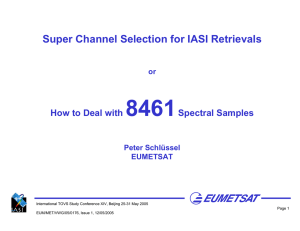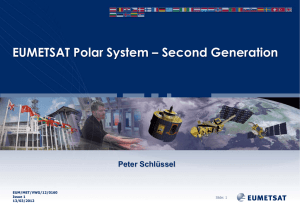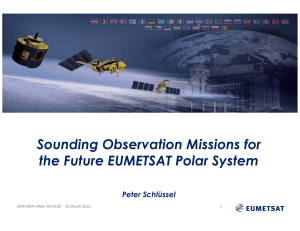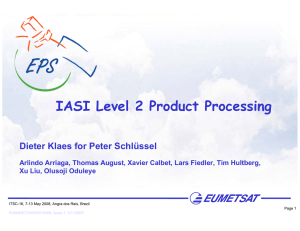IASI Product Generation, Products, and Data Access Peter Schl
advertisement
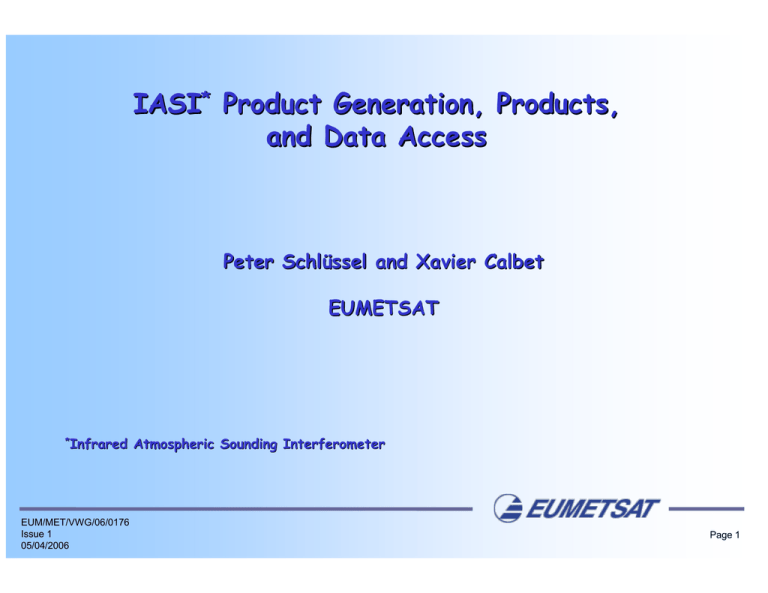
IASI* Product Generation, Products, and Data Access Peter Schlüssel and Xavier Calbet EUMETSAT *Infrared EUM/MET/VWG/06/0176 Issue 1 05/04/2006 Atmospheric Sounding Interferometer Page 1 Metop - fully integrated EUM/MET/VWG/06/0176 Issue 1 05/04/2006 Page 2 IASI Level 2 Product Generation High Level Break-Down IASI Level 1c AVHRR Cloud Mask and S/CTT ATOVS Level 2 AMSU-A Level 1 Configurable Databases MHS Level 1 NWP Forecast Pre-Processing Cloud Processing Geophysical Parameters Retrieval Monitoring Information EUM/MET/VWG/06/0176 Issue 1 05/04/2006 Level 2 Product Quality Information Page 3 Instruments’ Fields of View IASI AMSU-A MHS HIRS/4 AVHRR/3 EUM/MET/VWG/06/0176 Issue 1 05/04/2006 Page 4 Mapping of AVHRR to IASI IFOV 18Km 18Km 18Km 12Km 12Km 50 Km EUM/MET/VWG/06/0176 Issue 1 05/04/2006 12Km 12Km 50 Km Page 5 Properties of the Operational IASI L2 Processor (1/3) • For a best use of IASI measurements the level 2 processing can combine IASI with concurrent measurements of AVHRR, AMSU-A, MHS, and ATOVS Level 2 products • IASI stand-alone processing is possible if other measurements are not available, or if Product Processing Facility is explicitly configured to exclude other instruments • NWP forecast is included to provide surface pressure as reference for the profiles to be retrieved and surface wind speed over sea for the calculation of surface emissivity • Optionally, the NWP forecast profiles of temperature, water vapour and ozone can be used to initialise and/or constrain the retrieval EUM/MET/VWG/06/0176 Issue 1 05/04/2006 Page 6 Properties of the Operational IASI L2 Processor (2/3) • Processing is steered by configuration settings (80 configurable auxiliary data sets), which allow for optimisation of the Product Processing Facility before and during commissioning • Online quality control supports the choice of best processing options in case of partly unavailable IASI data or corrupt side information (data from other instruments or NWP forecast) • Besides error covariances a number of flags are generated steering through the processing and giving quality indicators; 40 flags are specified, which are part of the product EUM/MET/VWG/06/0176 Issue 1 05/04/2006 Page 7 Cloud Processing • • Cloud detection – AVHRR-based cloud detection using Scenes Analysis from AVHRR Level 1 processing – – Combined IASI / ATOVS cloud detection IASI stand-alone cloud detection Cloud parameters retrieval – – – Cloud fraction Cloud top height Cloud phase EUM/MET/VWG/06/0176 Issue 1 05/04/2006 Page 8 Clear and Cloudy IASI Spectra Clear Cloudy EUM/MET/VWG/06/0176 Issue 1 05/04/2006 Page 9 Discrimination between Ice and Water Clouds As Ci EUM/MET/VWG/06/0176 Issue 1 05/04/2006 Page 10 Geophysical Parameters Retrieval State Vector to be Retrieved • • • The state vector to be retrieved consists of the following parameters – Temperature profile at a minimum of 40 levels – Water vapour profile at a minimum of 20 levels – Ozone columns in deep layers (0-6km, 0-12 km, 0-16 km, total column) – Land or sea surface temperature – Surface emissivity at 12 spectral positions – Columnar amounts of N2O, CO, CH4, CO2 – Cloud amount (up to three cloud formations) – Cloud top temperature (up to three cloud formations) – Cloud phase In case of clouds and elevated surface the state vector has to be modified The level 2 product contains the state vector along with information on quality and processing options and compressed error covariance EUM/MET/VWG/06/0176 Issue 1 05/04/2006 Page 11 Geophysical Parameters Retrieval First Retrieval • Spectra PC scores regression for temperature and water-vapour, and ozone profiles, surface temperature, and surface emissivity • Artificial neural network (multi-layer perceptron) for trace gases (optionally also for temperature, water-vapour and ozone, depends on configuration setting) • The results from the first retrieval may constitute the final product or may serve as input to the final, iterative retrieval; the choice depends on configuration setting and on quality of the first retrieval results EUM/MET/VWG/06/0176 Issue 1 05/04/2006 Page 12 Retrieval Simulation: Example for Single Retrieval Arctic Atmosphere Truth Retrieval EUM/MET/VWG/06/0176 Issue 1 05/04/2006 Page 13 Retrieval Simulation: Example for Single Retrieval Mid-Latitude Atmosphere Truth Retrieval EUM/MET/VWG/06/0176 Issue 1 05/04/2006 Page 14 Final, Iterative Retrieval • Simultaneous iterative retrieval, seeking maximum probability solution for minimisation of cost function by Marquardt-Levenberg method, using a subset of IASI channels, combined to super-channels • Initialisation with results from first retrieval • Other choices of initialisation may be selected, depending on configuration setting and availability (e.g. NWP forecast, climatology, ATOVS Level 2 product) • Background state vector from climatology, ATOVS Level 2 product, adjacent retrieval, or NWP forecast, depending on configuration and availability • State vector to be iterated depends on cloud conditions and configuration setting (clear, cloudy, variational cloud clearing) EUM/MET/VWG/06/0176 Issue 1 05/04/2006 Page 15 Super-Channel Composition • Search for highly correlated radiances among all IASI spectral samples (noise-normalised radiances) and collect them in clusters – No need to have adjacent spectral samples – Correlation must be pre-determined at certain level: determines the number of clusters • Determine a lead channel in each cluster: Radiance and Jacobians will only be calculated for lead channel radiances yL(x) • Represent the measured radiance yLm of a cluster by a weighted average of all radiance samples which are members of the same cluster – Weights consist of regression coefficients, taking into account the correlation and the noise of the respective sample – Errors include measurement and regression errors 1 y Lm = N EUM/MET/VWG/06/0176 Issue 1 05/04/2006 N ∑ ai + bi yim i =1 Page 16 Radiative Transfer Simulations and Super-Channel Clustering • For a set of 53980 situations RTIASI-5 simulations have been carried out, assuming a random selection of possible scan angles • The resulting radiance spectra (apodised) have been normalised with the corresponding noise • A correlation analysis is done between spectral samples – All samples with a correlation higher than a threshold are retained in the respective cluster – The assumed thresholds vary between 0.95 and 0.999 • The lead sample is regressed against all other member samples of a cluster to obtain weighting coefficients and error estimates EUM/MET/VWG/06/0176 Issue 1 05/04/2006 Page 17 Super-Channel Properties Correlation EUM/MET/VWG/06/0176 Issue 1 05/04/2006 Number of Super-Channel Clusters 0.95 47 0.98 113 0.99 222 0.995 417 0.999 1633 Page 18 Population of Super-Channel Clusters EUM/MET/VWG/06/0176 Issue 1 05/04/2006 Page 19 Spectral Range Covered by Super-Channel Clusters EUM/MET/VWG/06/0176 Issue 1 05/04/2006 Page 20 Population of Super-Channel Clusters and Noise Reduction EUM/MET/VWG/06/0176 Issue 1 05/04/2006 Page 21 Examples of Super-Channel Clusters Correlation: 0.995 Cluster 6: 15 samples Lead: 647 cm-1 Cluster 3: 36 samples Lead: 645.75 cm-1 EUM/MET/VWG/06/0176 Issue 1 05/04/2006 Page 22 Test with AIRS Data: Preparation • The retrieval schemes have been tested extensively with real AIRS data and compared to co-located ECMWF forecasts and radiosonde measurements, focusing on temperature and water-vapour retrievals • Modification of the processing scheme: – Replacement of RTIASI by RTTOV-8 or SARTA in variational retrieval – Bias correction (additive constant per channel) based on global set of RT forward calculations with ECMWF forecast and co-located AIRS – Modification of EOF regression coefficients: adaptation to AIRS spectral and radiometric characteristics – Use of all “good” AIRS channels in first guess and variational retrievals, i.e. excluding black-listed channels with excessive noise characteristics – Adaptation of cloud detection schemes • Case studies in clear and cloudy situations with data from the EAQUATE campaign in summer 2004 EUM/MET/VWG/06/0176 Issue 1 05/04/2006 Page 23 EAQUATE Radiosonde Locations •MSG Ch 9 •8 August 2004, 01:12 UTC EUM/MET/VWG/06/0176 Issue 1 05/04/2006 Page 24 Inter-Comparison: Trappani •EOF first guess •No background •Physical constraint •69 minutes time difference EUM/MET/VWG/06/0176 Issue 1 05/04/2006 Page 25 Inter-Comparison: Zadar •EOF first guess •No background •Physical constraint •69 minutes time difference EUM/MET/VWG/06/0176 Issue 1 05/04/2006 Page 26 Test with AIRS Data: Results • Difference in retrieval performance using RTTOV or SARTA can be removed by appropriate bias correction • Initialisation of variational retrieval with results from first retrieval yields better retrieval performance than initialisation with climatology • Climatology as background leads to results strongly biased towards climatology and prevents the detection of fine structure • Physical constraints towards sub-adiabatic temperature profiles and non-saturated humidity profiles provide good performance • First guess is important for variational retrieval, the EOF regression is already highly performing • Introduction of a proximity constraint requiring the variational retrieval to stay close to first guess provides best results EUM/MET/VWG/06/0176 Issue 1 05/04/2006 Page 27 IASI Data Transmission and Processing • Satellite to ground transmission: – On-board storage and direct broadcast to local users – Down-link of global data to Svalbard receiving station after each completed orbit – Transmission of data to EUMETSAT Headquarters at Darmstadt • Data processing at EPS Core Ground Segment: – Generation of Level 1 products (decommutation, calibration, apodisation, geo-location, and mapping of imagery) – Generation of Level 2 products (geophysical parameters) • Distribution to users: – Near-real time transmission of products to users (Level 1: 2.25 hours, Level 2: 3 hours) via satellite broadcast (EUMETCast) – Distribution of sub-sampled data (spatially, and spectrally in case of L1) via GTS to WMO users (same timeline as NRT transmission) – Storage in Unified Archival and Retrieval Facility (UMARF) for later access by users (7 hours after measurement) EUM/MET/VWG/06/0176 Issue 1 05/04/2006 Page 28 Timeline for IASI Data Validation • • Metop-A launch: 17 July 2006 IASI switch-on: 21 July 2006 – – – • • • • • • • Followed by CNES Cal/Val Phases A and B A: Instrument activation and evaluation/system technical evaluation B: Early validation of Level 1 products First IASI measurements: 31 August 2006 Reference orbit for off-line testing available: 2 December 2006 Early Level 1 products available: 28 December 2006 CNES Cal/Val Phase C: In-depth validation of Level 1 Products Completion of Level 1 validation: 10 March 2007 Start of Level 2 validation: 29 January 2007 Completion of Level 2 validation: 21 May 2007 EUM/MET/VWG/06/0176 Issue 1 05/04/2006 Page 29
